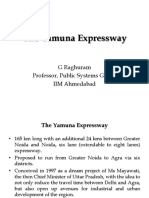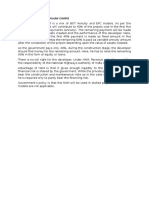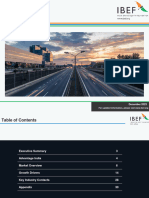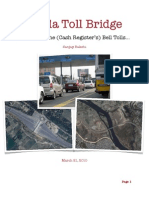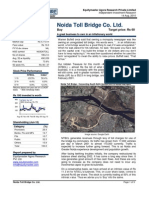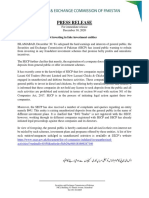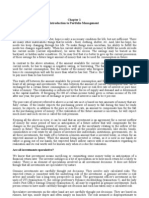Noida Toll Bridge
Noida Toll Bridge
Uploaded by
Phani MkmsCopyright:
Available Formats
Noida Toll Bridge
Noida Toll Bridge
Uploaded by
Phani MkmsCopyright
Available Formats
Share this document
Did you find this document useful?
Is this content inappropriate?
Copyright:
Available Formats
Noida Toll Bridge
Noida Toll Bridge
Uploaded by
Phani MkmsCopyright:
Available Formats
FINANCIAL MODELING
A Report on Noida Toll Bridge Company Ltd.
Anisha Bharati
Roll No. 020
Introduction: The Noida Toll Bridge Company Limited was incorporated as a Special Purpose Vehicle for the Delhi Noida Bridge Project on a Build, Own, Operate and Transfer (BOOT) basis. The Delhi Noida Bridge is an eight lane tolled facility across the Yamuna river, connecting Noida to South Delhi. The main advantage of using the bridge is the savings in time, distance and fuel consumption for travellers between South Delhi and Noida The Noida Toll Bridge Company Ltd. (NTBCL) has been promoted by Infrastructure Leasing and Financial Services Ltd. (IL&FS) as a special purpose vehicle (SPV) to develop construct, operate and maintain the DND Flyway on a Build Own Operate Transfer (BOOT) basis. NTBCL is a public listed company, incorporated in Uttar Pradesh, India, in 1996 and operates only in India.The main revenue source for NTBCL is collection of toll from vehicles crossing the bridge. The project was commissioned on February 7, 2001, almost 4 months ahead of schedule and broadly within the budget.
Background: The company initially had financial issues after the toll bridge was completed as the initial traffic projections did not materialize. The project was structured as a Rs. 408.2 crore (US$ 100m ) 30-year BOOT concession, which was financed through equity of Rs. 122.4 crore (US$ 30m) and debt of Rs. 285.8 crore (US$ 70m). Debt financing consisted of term loans from various Indian banks and financial institutions totaling Rs. 235.8 crore (US$ 58m) and the issue of deep discount bonds totaling Rs. 50 crore (US$ 12m) by the Noida Toll Bridge Company Limited (the concessionaire). The company had a highly leveraged structure (high debt) and hence had to get the debt re-structured. In addition the company also raised equity to improve the debt equity ratio. In the initial years of operation, the revenue from collection of toll fees at the Delhi Noida toll bridge fell below originally projected levels and below break-even level. The shortfall was attributed to a number of factors including the rate of growth of Noida being lower than expected. As a result of the financial losses incurred, NTBCL approached its lenders for the restructuring of its debt after its first year of operation. The restructuring was carried out in 2002.
The State Bank of India in conjunction with NTBCL, IDBI and IL&FS prepared the corporate debt restructuring proposal, the key features of which were: (i) rescheduling of interest and repayments; (ii) reduction in interest rate for loans; and (iii) construction of new links in order to augment NTBCLs revenues (to be funded by additional equity capital). As per the terms of the debt restructuring ,the Company issued Zero Coupon Bonds of Rs. 555.4 million to Banks, Financial Institutions and others, repayable no later than March 31, 2014, towards the Net Present Value of the sacrifice made by them. The Delhi Noida bridge project is often presented as a path-breaking project which showed that private capital could indeed be attracted to provide public infrastructure services in India despite having to deal with multiple authorities and a fragile political environment. The project was completed within budget and ahead of schedule. It was also successful in raising investment funds from capital markets (including an issue of GDRs overseas). Following significant shortfalls in projected traffic and revenues, it was also successful in restructuring its debt after the first year of operation. It is the only toll road in the country listed on the stock exchange.
Current financials: The company had a toll revenue of around 69 Crs in 2011. The company is also able to sell rights for outdoor advertising around the bridge and was able to earn around 12 Crs from it. The company was able to make a net profit of around 37 Crs on the above revenue base. The company has an operating expense of around 27%.The depreciation expenses are bound to remain fixed as there is not much addition to the fixed assets. The salary costs and some other expenses such as legal fees, travelling expense etc are variable and are bound to increase over time. The company thus has around 40-45 Crs of pretax profits available to service the debt. The company has been paying down debt which now stands at around 145 Crs in the latest quarter. At the current profit levels, the company should be able to pay off its entire debt in less than 3 years (though it may not happen due some of the re-structuring clauses). The company also has a leasehold title to around 99 acres of land which was awarded by the government as compensation for shortfall in the revenue. The company estimates this title to have a value of around 300 Crs. I have personally not ascribed full value to it as I dont have an idea on the status of this leasehold title or what the company plans to do with it (which the company describes as a risk)
Risks associated: Noida toll bridge was assured a 20% return on the cost of the toll bridge through toll collection and development rights for 30 years. In the initial years, the traffic projections did not come through and hence the actual returns were much lesser than the assured returns. The shortfall in the returns has been accruing to the company and one way of compensating the company would be to extend the 30 year operation period for the company. In other words, the company may be allowed to run the toll bridge for a much longer period. The leasehold title is definitely a risk for the company. Anything related to land always has some kind of political risks. The staff cost for the company is way too high. The company has around 15 employees and wage bill of almost 6 Crs. The key management personnel (CEO and a manager) are paid a salary of around 4Crs.I think the compensation costs of the company are high.
Finally, the company will generate quite a bit of cash flow once the debt is paid off. It is not clear what the company intends to do with the excess cash, though the company has started paying dividend in the current year. The Land Bank: Noida Bridge has huge land bank to the tune of 200 acres in Delhi and 30 acres in Noida. Value may unlock once the company gets a development rights from government. Land bank is valued at 1500crores. The price of the land is approximately Rs. 35000-40000 per square meter near that land bank. Apart from the core business of toll-collection, company has another non-core asset, which can be monetised in future. Company has in its possession, land bank of 200 acres in Delhi side and 30 acres in Noida side. NTBCL in its annual report mentions that there are risks involved with this land bank development Company has in its possession, land around the DND Flyway both in Noida and Delhi, which may be developed subject to grants of Development Rights by NOIDA / Govt. Of UP / Govt of Delhi. Though company has been trying to gain rights, it has been years and no rights have been granted till date. Some conservative estimates in 2002, valued this land bank at 350 crores. Taking an average 15% rise in land prices, this land bank can be valued at around 1100 to 1200 crores. The grant of rights can be a huge trigger for companys stock price.
They have a fair amount of land on both sides, in Delhi and in Noida, its part of their listing document. They are focusing on whether they can utilise a small portion of that land in Noida for which discussions are on with the Noida authorities. Financial analysis:
Source : MVXenius
As evident from figures above, barring 2010-11, NTBCL has been consistently increasing sales (revenues) as well as net profits. For 2010-11, sales are almost same as previous year. Though projected increase in traffic was 5%, the same did not materialise and led to stagnation of the income from toll collection.But a positive found in 2010-11 accounts is that there has been a considerable decrease in interests over the years. This augurs well for company as it is indicative of fact that company is retiring its debts and will turn debt free within 3 years. Even Debt/Equity ratio is decreasing for good. After results of 1Q-2011, the Debt/Equity stands at a comfortable 0.3.After all debt is serviced, entire profit will be used in increasing of EPS which currently stands at 2.01. And company, to give an indication of free cash being generated, for the first time, has declared dividend of 5% at FV 10. This is also an indicator that company will pretty soon turn into a regular dividend paying company, which shall give back the cash generated to its investors, as its debt obligations would be over.
At current market price of Rs 22.45, the company is available at a P/E of 11. With decreasing debt and increasing EPS, company is expected to come out with another 15-25% increase in EPS within 2-3 quarters; which works out to be Rs 2.3-2.5/ per share. Translating this into PE, we have a forward P/E of 8.90-9.60. Book Value stands at Rs 23.86. This translates into Price/Book Value (P/BV) of 0.94, which is satisfactory on fundamental valuation scales. Black Swan event It is an event or occurrence that deviates beyond what is normally expected of a situation and that would be extremely difficult to predict. Though it would be too farfetched to consider such an event while evaluating the company, the fact remains that Delhi (NCR) lies in a seismically dangerous zone of India. This area is prone to earthquakes (Same is validated by National Disaster Management Ministry of Home Affairs). And since NTBCLs only business is toll-collection, any damage to the bridge, would lead to a fall or total loss of revenue. References: 1. http://infrastructure.gov.in/pdf/NOIDA.pdf 2. http://essentialassociate.wordpress.com/2011/09/27/noida-toll-bridge-value-buy/ 3. http://www.ntbcl.com/investor.aspx 4. http://www.ntbcl.com/shareholding.aspx
You might also like
- Negotiable Instrument Law Philippines PDFDocument51 pagesNegotiable Instrument Law Philippines PDFRSQ100% (1)
- DND Noida Flyway Case StudyDocument12 pagesDND Noida Flyway Case Studysidcooper123No ratings yet
- Delhi Noida Toll BridgeDocument22 pagesDelhi Noida Toll BridgeAayush SharmaNo ratings yet
- Case Study: Airport Express Metro Line: Project Financing ModelDocument6 pagesCase Study: Airport Express Metro Line: Project Financing ModelrohitmahaliNo ratings yet
- Idm 31Document29 pagesIdm 31Sam RogerNo ratings yet
- E TicketDocument1 pageE TicketRoger BarretoNo ratings yet
- Sinha - Case Study Noida Toll BridgeDocument18 pagesSinha - Case Study Noida Toll BridgeSumitAggarwalNo ratings yet
- Report On Built Operate Transfer (BOT) Project: Project Name:-The Bandra Worli Sea Link BridgeDocument7 pagesReport On Built Operate Transfer (BOT) Project: Project Name:-The Bandra Worli Sea Link BridgeNagendra prajapatiNo ratings yet
- Report On Case StudyDocument17 pagesReport On Case StudyDaniel Kevin ThomasNo ratings yet
- Project Financing - A Case Study On Coimbatore Bypass Road Project DR - Hiren ManiarDocument3 pagesProject Financing - A Case Study On Coimbatore Bypass Road Project DR - Hiren ManiarVignesh SridharanNo ratings yet
- Guideline / Standard Operating Procedure (SOP) For Toll Notifications and Mandatory ETC Infrastructure in All Toll LanesDocument6 pagesGuideline / Standard Operating Procedure (SOP) For Toll Notifications and Mandatory ETC Infrastructure in All Toll LanesSourav BasuNo ratings yet
- Yamuna ExpresswayDocument20 pagesYamuna ExpresswayIshaan GuptaNo ratings yet
- Delhi Gurgaon Expressway (Bot)Document6 pagesDelhi Gurgaon Expressway (Bot)Avinash KommireddiNo ratings yet
- Rest Areas GuidelinesDocument17 pagesRest Areas GuidelinesviscalNo ratings yet
- DMRC Case StudyDocument20 pagesDMRC Case StudyAyush AroraNo ratings yet
- Yamuna Expressway: Jaypee Infratech LimitedDocument9 pagesYamuna Expressway: Jaypee Infratech LimitedSonali BhallaNo ratings yet
- Financing Road Projects in India Using PPP SchemeDocument13 pagesFinancing Road Projects in India Using PPP SchemeAneeb100% (2)
- The Coimbatore Bypass Road ProjectDocument11 pagesThe Coimbatore Bypass Road ProjectPrabudh BansalNo ratings yet
- Delhi Gurgaon ExpresswayDocument5 pagesDelhi Gurgaon ExpresswayAnubhav Bigamal100% (1)
- Key Development Public Private Partnership Projects at Mumbai: Selected Case StudiesDocument5 pagesKey Development Public Private Partnership Projects at Mumbai: Selected Case StudiessadhanaNo ratings yet
- HUDCO PresentationDocument6 pagesHUDCO PresentationAbhishek RaoNo ratings yet
- Rajasthan Mega Highways ProjectDocument45 pagesRajasthan Mega Highways ProjectRohit RameshNo ratings yet
- PPPs Tollway EngDocument28 pagesPPPs Tollway EngASHINo ratings yet
- Toll Roads - Managing Traffic and Revenue RiskDocument2 pagesToll Roads - Managing Traffic and Revenue RiskRohan ShahNo ratings yet
- Pipavav Rail Corporation-Ppp Case Study 2008Document25 pagesPipavav Rail Corporation-Ppp Case Study 2008kaushalmehta100% (1)
- Viability Gap Funding PaperDocument5 pagesViability Gap Funding PaperNiranjanNo ratings yet
- Deloitte On PPPDocument15 pagesDeloitte On PPPindiangal1984100% (1)
- Project Management Report On Delhi Metro Airport ExpressDocument17 pagesProject Management Report On Delhi Metro Airport ExpressPriyanka Khandelwal100% (1)
- Hybrid Annuity Model For Road ProjectsDocument1 pageHybrid Annuity Model For Road ProjectsbuntysuratNo ratings yet
- Vadodara Halol Toll RoadDocument7 pagesVadodara Halol Toll RoadHimanshu PatelNo ratings yet
- Dhaka Metro Rail ProjectDocument22 pagesDhaka Metro Rail ProjectNiloy nillNo ratings yet
- Sustainable Transport by World Bank (1996)Document146 pagesSustainable Transport by World Bank (1996)ayuNo ratings yet
- Malaysia Penang BridgeDocument7 pagesMalaysia Penang BridgeJeevanend ArumugamNo ratings yet
- A Comparative Analysis of PPP Financing PDFDocument14 pagesA Comparative Analysis of PPP Financing PDFRuslan KuzhekovNo ratings yet
- Developing Bus Rapid Transit System in IndiaDocument14 pagesDeveloping Bus Rapid Transit System in Indiaharishreddy1985No ratings yet
- Current Status & Future of The Oman-GCC Railway - Abdulrahman Al Hatmi - MOTCDocument20 pagesCurrent Status & Future of The Oman-GCC Railway - Abdulrahman Al Hatmi - MOTCSTP DesignNo ratings yet
- EOI-Light House TenderDocument98 pagesEOI-Light House Tenderraj.mehta2103No ratings yet
- E - Tender BangladeshDocument14 pagesE - Tender Bangladeshমোঃ আরাফাত উল হক100% (1)
- Nicmar AssignmentDocument17 pagesNicmar Assignmentanil_kishor_1No ratings yet
- Delhi-Gurgaon ExpresswayDocument12 pagesDelhi-Gurgaon ExpresswayboldfaceaxisNo ratings yet
- Final PDF - Opbrc - 18.05.2020 PDFDocument104 pagesFinal PDF - Opbrc - 18.05.2020 PDFRakhesh RaghavNo ratings yet
- Sustainable Rest AreaDocument31 pagesSustainable Rest AreaJogie Suherman100% (1)
- Final Manual For Specification StandardsDocument192 pagesFinal Manual For Specification Standardsbhargavraparti100% (1)
- DMRCDocument15 pagesDMRCsangeetaangel100% (1)
- Mumbai Traffic StatsDocument6 pagesMumbai Traffic StatsBhuvana_bNo ratings yet
- MPR MKTL DEC 2020 Final 12Document61 pagesMPR MKTL DEC 2020 Final 12Karthi KeyanNo ratings yet
- Assignment - Tendering Bidding and ContractingDocument6 pagesAssignment - Tendering Bidding and ContractingPrabhakar KhairateNo ratings yet
- NICMAR ASSIGNMENT - Management of PPPDocument37 pagesNICMAR ASSIGNMENT - Management of PPPjijo.b.raj100% (3)
- Presentation On Traffic ForecastingDocument19 pagesPresentation On Traffic ForecastingMukul Garg100% (1)
- Feasibility Study Report of Bangluru-Chennai ExpresswayDocument54 pagesFeasibility Study Report of Bangluru-Chennai ExpresswayAsom Mala Group5100% (1)
- Delhi Metro ProjectDocument19 pagesDelhi Metro Projectsheenahasan100% (2)
- Intelligent Transportation SystemDocument23 pagesIntelligent Transportation SystemAshok RajanavarNo ratings yet
- Road December 2023Document33 pagesRoad December 2023Varun SinghNo ratings yet
- NHAIFinalDocument48 pagesNHAIFinalhimanshusabooNo ratings yet
- Features: Delhi Metro: Setting An Example in India (Free Access)Document4 pagesFeatures: Delhi Metro: Setting An Example in India (Free Access)Sanjay Rao KondalaNo ratings yet
- Noida Toll BridgeDocument12 pagesNoida Toll BridgeqleapNo ratings yet
- No Ida 110Document9 pagesNo Ida 110suvendu69No ratings yet
- DND FlywaypptDocument18 pagesDND FlywaypptMitanshu BansalNo ratings yet
- Garuda UdyogDocument6 pagesGaruda UdyogAbrar AhmedNo ratings yet
- Automotive Axles LTD.: An Assignment ReportDocument8 pagesAutomotive Axles LTD.: An Assignment ReportAshwani RaiNo ratings yet
- IRB Infrastructure Developers LTDDocument18 pagesIRB Infrastructure Developers LTDSwati SinhaNo ratings yet
- NoidaDocument23 pagesNoidaAmmar Tambawala100% (1)
- International Bond Market ParticipantsDocument6 pagesInternational Bond Market ParticipantsNandini JaganNo ratings yet
- Mcom Semester IIIDocument11 pagesMcom Semester IIIuma deviNo ratings yet
- Resume of Chapter 11 Return, Risk, and The Capital Asset Pricing ModelDocument5 pagesResume of Chapter 11 Return, Risk, and The Capital Asset Pricing ModelAimé RandrianantenainaNo ratings yet
- Managing Interest Rate RiskDocument32 pagesManaging Interest Rate RiskHenry So E Diarko100% (1)
- Press Release Dec 30 SECP Warns Public Against Investing in Fake Investment Entities Lasani GroupDocument2 pagesPress Release Dec 30 SECP Warns Public Against Investing in Fake Investment Entities Lasani GroupRabab RazaNo ratings yet
- ReportNSECM R237379Document1 pageReportNSECM R237379Hitesh ChhatriwalaNo ratings yet
- Tompdf PDFDocument4 pagesTompdf PDFSyed Qamar Abbas100% (1)
- QuestionnairesDocument2 pagesQuestionnairesSandeep MadivalNo ratings yet
- Exceptions Modifications AdaptationsDocument4 pagesExceptions Modifications AdaptationsMOUSOM ROYNo ratings yet
- AccuraCap PMSDocument35 pagesAccuraCap PMSAnkur100% (1)
- Portfolio ManagementDocument104 pagesPortfolio ManagementAbhijit ErandeNo ratings yet
- 12Document8 pages12Ishaq EssaNo ratings yet
- CFD Pro Trader Platform (Hotkey Manual)Document4 pagesCFD Pro Trader Platform (Hotkey Manual)Anonymous Xt5PxTNo ratings yet
- IBFS 2 Till 0807Document209 pagesIBFS 2 Till 0807neeraj_adorable4409No ratings yet
- ASIC Current & Historical Company Extract For Inter-Port Global Pty LTDDocument3 pagesASIC Current & Historical Company Extract For Inter-Port Global Pty LTDclarencegirlNo ratings yet
- Robert Kiyosaki - John T. Reed Analysis of Robert Kiyosaki BDocument42 pagesRobert Kiyosaki - John T. Reed Analysis of Robert Kiyosaki BHengleenaNo ratings yet
- Glide Path ComparisonDocument2 pagesGlide Path ComparisonChrabąszczWacławNo ratings yet
- Chapter 11 Summary and Questions PDFDocument2 pagesChapter 11 Summary and Questions PDFTedi Saleh100% (1)
- TDS Rates-24-25Document26 pagesTDS Rates-24-25bosearindrajitNo ratings yet
- Session 1 Introduction To BFSIDocument2 pagesSession 1 Introduction To BFSIGopal Gidwani0% (1)
- Type Listed On NBP Industry: PKR 50.569 BillionDocument12 pagesType Listed On NBP Industry: PKR 50.569 BillionLovely JeniNo ratings yet
- BMSR 2016 PDFDocument205 pagesBMSR 2016 PDFFitria Rizal Eka PutriNo ratings yet
- MackayDocument2 pagesMackaytpobrien101No ratings yet
- CH 10Document17 pagesCH 10Mahmoud HamedNo ratings yet
- Week 6 Tutorial SolutionsDocument8 pagesWeek 6 Tutorial SolutionsManoaNo ratings yet
- Strategies of Unrelated DiversificationDocument11 pagesStrategies of Unrelated DiversificationVikram Falor0% (1)
- Tee Ling Kiat Vs Ayala CorpDocument1 pageTee Ling Kiat Vs Ayala CorpMir SolaimanNo ratings yet
- Deutsche Finan ExcelDocument6 pagesDeutsche Finan ExcelAnonymous VVSLkDOAC1No ratings yet











